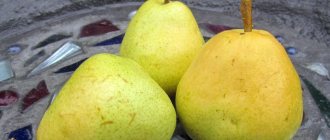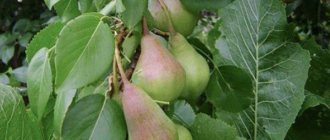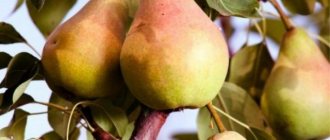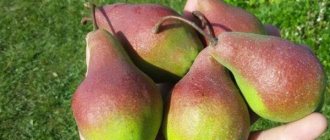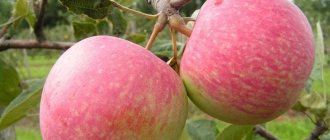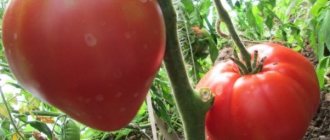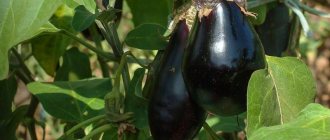How to choose a pear variety for the Moscow region
The climate in the Moscow region is temperate continental and is characterized by uneven precipitation throughout the year. Often, most precipitation falls as rain in the spring and autumn, followed by a dry period in the summer. In the first months of winter there are severe colds, accompanied by strong winds, but without snow. And recurrent spring frosts with a sharp drop in temperature to sub-zero temperatures can be repeated in the Moscow region throughout almost the entire spring.
Pears for the Moscow region - video
Therefore, in such difficult climatic conditions as in the Moscow region, it is better to plant early ripening pear varieties, or varieties that are zoned by breeders for cultivation in the appropriate climate. It is possible to plant modern pear varieties that are highly resistant to diseases and pests, resistant to rust, scab and a number of other diseases characteristic of many pear varieties.
It’s not that difficult to make a rating of pear varieties that are the best for growing in the Moscow region. Below are presented only the most popular pear fruit trees, divided by fruit ripening time, as well as other important criteria.
Pear care in autumn and spring
In the fall, it is necessary to carry out the following pear care activities:
- sanitary pruning of branches;
- fertilizing with phosphorus fertilizers;
- preventive treatment against pests and diseases;
- whitewashing the tree trunk with lime;
- deep watering of the tree trunk area and digging;
- covering the tree trunk area with a 20 cm layer of sawdust.
In the spring, pear care comes down to removing covers and repeating autumn care measures using nitrogen fertilizers instead of phosphorus fertilizers.
Self-fertile pear varieties for the Moscow region
Most pear varieties developed in the last century are self-sterile and therefore require the presence of nearby pollinating trees. But thanks to the efforts of breeders, new pear varieties and hybrids have recently appeared that are self-fertile.
Pear care - video
For cultivation in the Moscow region, it is recommended to plant the following varieties of self-fertile pears:
- Lada;
- Krasulya;
- August dew;
- Red-sided;
- Muscovite;
- Dressed up Efimova.
However, according to the experience of gardeners, the presence of nearby pollinating trees increases the yield of these pear varieties by about 1/3.
PEAR!
Summer Duchess pear (Williams)
Features of the climate zone
The Moscow region is located in the temperate continental climate zone. It is characterized by uneven distribution of precipitation. It happens that the bulk falls in autumn or spring. And in the summer there is drought. At the beginning of winter, severe frosts are not uncommon, accompanied by a sharp north wind. And in late spring there are recurrent frosts, when the temperature sets below zero for several days.
In such conditions, caring for the southern pear is quite difficult. The tree blooms early, and repeated spring frosts may prevent the flowers from pollinating and destroy the ovaries.
Growing the crop is difficult, since fruit buds are formed in the previous summer and can freeze in winter.
In conditions of a short warm period, it is recommended to plant early-ripening and early-fruiting varieties and hybrids. They begin to produce a stable harvest in the 3rd year of the tree’s life in the garden.
The sweetest pear varieties for the Moscow region
Most pear varieties recommended for cultivation in the Moscow region have a good taste; the fruits contain a large amount of sugars and a low acid content. But there are a number of varieties whose fruits, even in a state of incomplete biological maturity, already contain a large amount of sugars, so they are the most delicious of all known pear fruit trees.
Pear "Autumn sweet"
The ripened fruits of Autumn Sweet are considered dessert. Their shelf life is up to 60-75 days. From each mature pear you can collect over 27-30 kg of ripe produce. Harvested pears have a beautiful appearance, so they are gladly bought up at the market. Sweet autumn pear is resistant to cold weather and is practically not affected by diseases.
Buttery sweet
Pears of this variety are large, weighing up to 180 g, with a greenish color, on which a slight blush appears. The pulp is sweet and oily, with little noticeable acidity. Pears are not prone to shedding after ripening. The obvious advantages of Buttery Sweet are:
resistance to scab and cold. Ripe pears tolerate transportation well; the fruits can last no more than 14-20 days.
Vidnaya (lumpy)
Vidnaya pear is distinguished by early fruiting - it is possible to harvest from a tree already in the 4th season after planting young plants on the site. The Tuberous pear variety has excellent resistance to cold, scab and powdery mildew.
Productivity is stable and high. Flowering in this variety occurs late, and therefore the likelihood of damage to the buds by spring frosts is low. Sweet and juicy pears of the Vidnaya variety will appeal to the most avid sweet tooths.
What criteria should pear varieties meet for the middle zone?
Pear fruits are one of the healthiest fruits. Contains sugars, organic acids, fiber, pectin, nitrogen, tannins, iodine, vitamins, carotene
When choosing, you need to pay attention to varieties whose fruits are rich in these elements. Since the crop will be grown in difficult climatic conditions, it is better to purchase trees that meet the following requirements
- Frost resistance and tolerance of temperature changes without cracking of the bark.
- Short growing season. From flowering to fruit ripening no more than 120 days.
- Disease resistance.
Important! The main criterion is that the fruits must be tasty
Recently, many sweet, juicy, relatively shelf-stable varieties, close in taste to southern species, have been bred for the central European part of Russia.
It is worth paying attention to the pears obtained at the All-Russian Breeding and Technological Institute of Horticulture and Nursery Growing in Biryulyovo Vostochnoye, which specializes in breeding and acclimatization of varieties in Moscow and the Moscow region
Another important criterion is the shelf life of the crop. Pears do not lie well, but you can still choose varieties that will last 1-2 weeks longer than other fruits of similar ripening periods.
Early pear varieties for the Moscow region
Pear trees, characterized by early ripening of fruits, are also popular among gardeners in the Moscow region, since the harvest from such fruit crops can be harvested by the last ten days of July.
APRICOT!
Apricot Alyosha Apricot LEL Apricot Tsarsky
Pear "Skorospelka"
This variety is one of the earliest among the pear varieties that are recommended for cultivation in the Moscow region. The Skorospelka pear calmly survives severe cold - it can withstand frost down to -38-40 degrees Celsius.
The trees are harvested in late July. Fruiting is stable and regular.
Fabulous
Trees of this variety grow up to 3.5-4 m in height and have a beautiful pyramidal crown. The shape of the fruits of this variety is typically pear-shaped, with yellow skin. Weight of ripe pears of the Skazochnaya variety – 200-250 g.
Pear variety "Cathedral"
This pear tree is grown not only in small garden plots, but also on an industrial scale. Cathedral is an unpretentious variety that does not require complex care. The first harvest appears on the trees in Season 3 after the trees have taken root in their new location. The weight of a ripe pear is up to 130-140 g. But the harvested crop is not stored for long - after a week or a week and a half, the fruits begin to deteriorate.
Low growing varieties
Pear is a crop that needs sunlight and free space. If you plant trees close to each other, this will have a bad effect on the yield. In order to accommodate more species in the area, the plants must be low-growing. This does not affect the taste in any way.
Olivier de Serres
This tree has straight shoots growing upwards; the crown is compact. The fruits ripen in autumn: they are round and weigh approximately 150 g. The skin color is gray-green with cinnamon-colored spots.
The creamy flesh is very sweet and juicy - the pear has an almond aftertaste. The fruit hangs for a long time without falling off. They can be transported and stored for a long time. Suitable for fresh consumption and making compotes.
Parisian
Dwarf variety - the tree does not grow more than 3 m. Harvesting is carried out in early October. The weight of the fruit varies between 200–250 g.
Attention!
Dwarf plants bear fruit 2–3 years after planting—you can harvest 4–8 kg of crop from one tree.
Parisian has sweet flesh with a slight sour aftertaste. She does not suffer from fungus and rot. The fruits are universal: suitable for consumption in any form.
In memory of Yakovlev
This variety ripens in early autumn. It is distinguished by a small crown and thick branches. The fruits have a classic shape and weigh about 110 g. The peel is smooth, dense with a yellow color and a slight blush.
The taste of Memory Yakovlev is sweet, there is no sourness or astringency. Harvest storage is up to 90 days.
The best varieties of low-growing pears for the Moscow region
Low-growing varieties of pears are very popular among gardeners in the Moscow region, since they do not take up much space, it is easier to harvest from them, and the yield from them, although not too high, is still sufficient for personal farms.
Pear "Bere Gardi"
The Bere Gardi pear is the fruit of the work of French specialists who created this pear many decades ago. The Bere Gardi pear was grafted onto a quince and can reach a height of 3.5-4 m.
The higher the size of the tree, the larger the fruits ripen on it. In general, the weight of pears is 160-180 g. The first harvest from Bere Gardi is harvested 3 years after planting the trees in the garden plot. Pears begin to ripen from the tenth of September.
Pear variety "Velesa"
According to the timing of fruit ripening, Veles pear belongs to the autumn varieties.
The first pears from this fruit tree can only be collected in the 7th season after they are planted on the site. The Veles pear has a round shape, without ribbing. The Veles variety belongs to dessert pears; the collected fruits can be stored for up to 60 days.
Grand Champion
According to the timing of fruit ripening, the Grand Champion pear is classified as an autumn variety. Pears begin to ripen in the last ten days of September. The productivity of the variety is high. Weight of ripe fruits – 210-240 g. The color of ripe pears is golden, the flesh is cream-colored, sweet with an oily taste. The harvested crop can be stored for up to six months.
When does a pear blossom and ripen in the Moscow region?
Pear blossoms in May or early July. The exact timing depends on the growing area and weather conditions. The warmer the climate, the earlier flowering occurs. Most varieties bear fruit in the 3rd year, but there are also those that produce fruit only in the 5th, 6th or 7th year after planting.
Attention! When to remove pears from the tree? The ripeness of the fruit is determined by the change in color and fragrant sweet aroma. The pear becomes elastic, but not hard.
The ripening period of early summer varieties begins on July 20 and ends on August 30. Trees of autumn varieties bear fruit throughout September. Late pears produce a harvest in October and November.
Columnar pear - varieties for the Moscow region
Columnar pears have recently become increasingly popular among gardeners due to their compactness, small size of trees, and early fruiting. Although the yield of such varieties is, of course, much less than that of ordinary pear varieties, this is not a serious drawback for summer residents whose garden plot is not too large. And another disadvantage of columnar pears is that the trees age too quickly. In the Moscow region, many summer residents also like to grow columnar pears.
APPLE TREE!
Amber Necklace Moscow Columnar Necklace Ostankino
Columnar pear “Early winter Dalikor”
This columnar pear reaches a height of 1.4-1.5 m. The fruits ripen in the first mid-autumn, they are distinguished by excellent keeping quality - they can lie in the cellar for up to 5 months.
The taste of a ripe pear is pleasant, with delicate pulp and creamy color.
Summer Decor
This self-fertile summer variety is characterized by excellent fruiting, frost resistance, and early ripening.
– the first fruits on pear trees appear three seasons after the plants are planted in the garden plot. But the collected fruits are not stored for long - no more than 12-14 days.
Columnar pear “Autumn Dream”
The harvest from this columnar variety can be harvested at the end of the summer season. Ripe pears are greenish-yellow in color; small pears weigh no more than 75 g. The collected fruits are used for canning or making aromatic jam. Autumn Dream is distinguished by its high resistance to harsh winters.
Honey
This pear variety is classified as late-ripening, the fruit size is large, weighing about 350-400 g. With proper care, each tree of this variety can produce up to 14-14.5 kg of ripe produce. Honey pear is distinguished by its unpretentiousness, sufficient frost resistance and good immunity.
What are the features of the climate of the Moscow region?
The Moscow region is characterized by frosty winters and sunny, hot summers. Average temperatures can only be observed in spring and autumn, and then with significant fluctuations. Precipitation is not uncommon in this region; it occurs evenly throughout the year. However, in summer there may be dry weather for 1-2 months.
First of all, it is resistance to severe frosts and drought.
It is worth noting the peculiarities of winters, due to which many garden crops suffer. Precipitation is not always good for plants and in this case, the problem in this region is quite high humidity, which makes winters frosty and very cold. Frostbite of trees is not uncommon here; some crops can freeze completely, without a chance of recovery in the spring, so you need to choose the variety very carefully.
What qualities should the best pear varieties for the Moscow region have? First of all, it is resistance to severe frosts and drought. But it is also important that the variety be productive and have tasty fruits for fresh consumption and processing.
Winter varieties of pears for the Moscow region
Late-ripening pear varieties do not have time to ripen in the conditions of the Moscow region. Therefore, the fruits are collected at the stage of incomplete ripeness and left to ripen in storeroom conditions. This crop attracts gardeners with the good taste of pears and the ability to store the crop for a long time. Next, we list the best varieties of winter pears for the Moscow region.
Winter pear variety “Chudesnitsa”
Miracle is a hybrid obtained by crossing pear trees Daughter of the Dawn and Talgar Beauty. The main advantages of the hybrid:
high immunity, stable fruiting, pleasant taste of ripe pears. Harvested pears can be stored for up to 4.5 months.
Extravaganza
The harvest from this pear tree is in greatest demand on the market. The fruits are not prone to shedding and have a long shelf life. The Extravaganza pear is distinguished by excellent fruiting and resistance to most diseases.
Winter pear "Novella"
The main advantages of this pear:
high resistance to frost - can withstand cold temperatures below -30-32 degrees Celsius, early fruiting, resistance to a number of diseases, including fungal ones, large size of pears - up to 170-175 g, excellent taste of ripe pears.
PEACHES!
Voronezh Peach Greensboro Peach Redhaven Peach
Winter pears "Nika"
The main advantage of the Nika pear is its large fruit size with a fruit weight of up to 190-195 g. The taste of ripe products is sweet with a slight sourness. Productivity is high, fruiting is stable, annual. The harvested crop can be transported to any distance and can be stored in appropriate conditions for up to 4.5 months.
Winter
Among the wide variety of pears, winter varieties are preferred for their long shelf life and increased resistance to frost. Below are winter varieties that are considered the best.
Saratovka
A variety obtained by crossing German Bergamot and Winter Bere pears. The fruits are medium, weight reaches 120-140 g. The shape of the fruit is elongated pear-shaped, the surface is smooth. The peel is oily, dull and dense, greenish-yellow in color, becoming yellow when ripe. The peduncle is short, curved. Snow-white, oily pulp with a sweet and sour taste.
The advantages of the variety include increased resistance to diseases and temperature changes, presentation and good taste of pears.
Fruiting occurs in the 5th year after planting the seedling. The variety is characterized by high productivity - up to 24 tons of ripe fruits are harvested from 1 hectare.
Kondratyevka
Winter variety. The tree is tall, reaches up to 10-12 m, has a pyramidal trunk shape and slightly drooping branches. It grows slowly, but over time this becomes an advantage - more and more fruits appear.
The fruits are large, their weight reaches up to 230 g. The peel is green, slightly yellowish. The fruits are juicy, tender and pleasant in taste and aroma. The peduncle is thick, curved. The shape is regular, pear-shaped.
Fruit ripening occurs in early and mid-September. The tree begins to bear fruit 4-5 years after planting. Gardeners value the Kondratyevka pear for its resistance to cold, diseases and pests.
Pass-Krasan
French winter pear variety. The fruits are suitable for fresh use and for technical processing. The medium-sized fruits weigh up to 180 g and have a bergamot-shaped or spherical shape. There are rusty or gray specks on the surface. The peel is thin, but dense, with a slight roughness, and an orange-yellow hue. The peduncle is short and thick, slightly curved, straight. The creamy pulp is juicy and sweet, with slight acidity and a pronounced aroma.
Fruiting occurs 6-7 years after planting the seedling. The variety is characterized by average yield - up to 10-15 kg of ripe pears are harvested from 1 tree.
Seedlings are planted in rich soils, trees are pruned, a crown is formed and fertilizers are applied. Such procedures will speed up tree growth and increase productivity.
Pervomayskaya
The fruits of the Pervomaiskaya variety are characterized by a pear-shaped shape, their length reaches about 10 cm, and their average weight is 150 g. The surface is smooth, yellow in color, there are no spots or blush. There is a dense waxy coating on the peel.
The pulp is juicy, soft, not watery, creamy in color. Pears are sweet, pleasant to taste, without bitterness or acid, somewhat reminiscent of peach or pineapple. Pleasant aroma.
The seedling is planted in the spring, in early March. For planting, choose well-lit areas where there are no barriers or building structures. About 40 kg of ripe fruits are harvested from 1 tree.
Lyra
Lira was bred by crossing the Bere Winter and Forest Beauty varieties. The fruits ripen in mid-September. When harvesting, the yellow fruits with a greenish tint are removed. One pear weighs 200-250 g, has a regular pear-shaped shape with a slight bevel. The creamy pulp is very juicy, sweet with a slight presence of acid. The aroma is weak.
The pear begins to bear fruit 3 or 5 years after planting. Choose one- or two-year-old seedlings. The planting procedure is carried out in autumn or spring. It is better to plant seedlings in areas where the sun constantly shines and there are no drafts.
As they are stored, the fruits turn yellow and their color becomes bright. Pears can be stored until December-January, sometimes they do not spoil until the end of March.
Domestic
The variety was developed in 1934 by crossing Dekanka winter pears and Vera Boek pears. The tree is not tall and has good winter hardiness. Productivity is average, annual.
The fruits have a regular pear shape and a greenish-yellow peel. The fruits are medium or large in weight, reaching 170-200 g. The pulp is creamy, juicy, tender, the taste is sweet and sour.
The first fruiting occurs 4-5 years after planting in the ground. The fruits fully ripen in mid-October and can be stored well until the end of December. When stored in the refrigerator, they do not lose their external characteristics until March.
Summer pear varieties for the Moscow region
These types of pears are distinguished by a short growing season, while the fruits ripen in several months, have a good taste and excellent presentation, but have a short shelf life of no more than 15-20 days. The most suitable varieties of summer pear for the Moscow region are presented below.
Review of summer pear varieties - video
Lada
This fruit tree is a fairly old variety, but is still popular among gardeners due to its early fruiting (the pear begins to bear fruit 3 seasons after planting the pear seedlings), self-pollination, resistance to scab, and high resistance to frost.
– fruit buds do not freeze at temperatures down to -24-26 degrees Celsius. The Lada pear has a high yield - up to 35-45 kg of ripe produce is collected from an adult tree per season.
Summer pear variety "Krasulya"
The height of this pear tree can reach 3.5-4 m; the distinctive feature of the variety is its spreading crown and the presence of prickly thorns on the central trunk and shoots. Fruits with blush on the sides appear on the shoots of the previous and current seasons. The fruits are sugary, they contain at least 10.5-11.35% sugars. The main positive qualities of this fruit tree are resistance to scab and spider mites, as well as bud resistance to cold temperatures - down to -24-25 degrees Celsius, which is very important for the climate of the Moscow region. However, the fruits of this pear are characterized by low shelf life.
August dew
The harvest from trees of the Augustow dew variety is harvested in the last ten days of August. The taste of ripe fruits is sweet with slight acidity, the pulp is slightly grainy. This pear tree is highly resistant to scab and pest attacks.
Fruiting of the August Dew variety begins three seasons after the seedlings are planted in a permanent place. At least 13-14 kg of ripe produce is collected from each tree. The height of an adult tree can reach 2.3-2.5 m. Pears do not fall off the branches after ripening.
Cathedral
This pear tree is distinguished by its large height (up to 3.5-4 m) with a very dense crown, which should be pruned annually. The tree is resistant to cold temperatures down to -26-27 degrees Celsius. Cathedral pear is resistant to periods of drought. Fruiting in this variety is stable and annual. The fruits are sweet, with a slight sourness. Cathedral pear trees are highly resistant to major diseases and attacks by “harmful” bugs.
Summer pears "Chizhevskaya"
This fruit tree was the most popular among Russian gardeners a couple of decades ago and was found in almost every garden plot. The main reason for this popularity is the very high yield, since up to 55-59 kg of ripe fruits could be harvested from one mature tree. Ripening pears are not prone to shedding. The trees are distinguished by their small height - up to 2.9-3.1 m. The Chizhevskaya pear is resistant to cold and periods of drought.
Ripening in summer
The summer-ripening group includes varieties that produce a harvest of ripe fruit in the last ten days of July or August. Summer varieties do not have a long shelf life, so they are recommended for consumption or processing within a week after collection.
Almost all early ripening varieties are self-fertile crops. However, to increase productivity, gardeners carry out additional pollination of trees. To ensure this condition, pollinating plants are planted nearby and bloom at the same time.
Summer pear varieties for the Moscow region are divided into three types of plants:
- the first species ripens in the last ten days of July;
- the second - in mid-August;
- the third - closer to the beginning of autumn.
Lada
The low-growing, compact variety Lada is resistant to drought and harsh climatic conditions. The pyramid-shaped crown reaches a height of about 2.5 m.
The fruit is yellow with a pink blush, weighing about 150 g. Harvesting is carried out in mid-July. The first fruits are given in the 3-4th year of cultivation. The crop is self-fertile, but needs pollinators to increase productivity. The Rogneda and Chizhevskaya varieties are planted nearby.
Variety Lada
The main advantages are high yield, immunity against scab and fungal infections.
Krasulya
A relatively new variety of domestic selection is Krasulya, the characteristics of which include the following qualities:
- average height - about 4 m;
- the crown is wide, densely covered with large green leaves;
- shoots drooping, covered with thorns;
- The fruit is yellowish-green, spherical in shape, weighing about 120 g.
The Krasulya variety is a productive species with a high degree of frost resistance.
Pear variety Krasulya
It is not subject to scab, increases productivity when the Raduzhnaya and Severyanka varieties are adjacent.
Marble
The tree is of medium height - at maturity it reaches 4 m in height. The branches are spreading, the first fruit ovaries form in the 6-7th year of cultivation. The fruit is green with a red side. The pulp is moderately juicy and sweet. Harvest ripening occurs in mid-August. But if there is a lack of moisture in the soil, the tree begins to drop its fruits prematurely.
Pear Marble
The Mramornaya variety is resistant to fungal diseases and is practically not damaged by scab. The plant has good resistance to severe winters and bears fruit annually.
August Dew
The Augustow Dew culture was obtained on the basis of two varieties - Triumph Pakgama and Tenderness. The newly bred hybrid received the best qualities of its parents - good frost resistance, early ripeness (it enters the fruiting phase after 4 years) and consistently high productivity.
Variety August Dew
The crown is round, drooping, and medium dense. The pear is bright yellow, sweet, very juicy, average weight - 140-150 g.
The Lyubimitsa Yakovleva variety is considered the best pollinator.
Cathedral
The Cathedral pear variety is one of the few that has increased resistance to all fungal diseases. It is also not susceptible to pear mite infection and fire blight. The degree of frost resistance is high.
Pear Cathedral
The fruits are yellow, pear-shaped, very juicy, with a sweet and sour taste. Small specimens can be stored for about 3-4 weeks in a cool place.
Red-sided
The large-fruited variety Krasnobokaya has excellent taste - pears reach 200 g in weight. Therefore, it is necessary to harvest the crop before the required ripening period, otherwise there is a high risk of branches breaking off. The fruit is yellow, hard, but after full ripening the pulp becomes very juicy and sweet.
Gruga Redside
Both young and mature trees have good immunity against fungal, viral and bacterial infections. They easily tolerate cold wintering in the region.
Chizhevskaya
The tree is small in stature - about 3 m, stable and produces good harvests every year. The disadvantage of the Chizhevskaya variety is that the fragrant and juicy fruits can be stored for no more than a week, so they are immediately eaten or processed.
The dwarf crop has winter hardiness and early ripening - it produces its first harvest in the third year of life. For additional pollination, the Lada pear variety is planted next to the tree.
Fabulous
An early-ripening, large-fruited Fabulous crop - fruit weight reaches 250 g. Green pears with a red side, very sweet and juicy, can be stored for no more than two weeks, so they require quick sales and processing.
Pear variety Fairytale
The plant is tall - up to 5-5.5 m in height, which makes harvesting difficult. Has good recovery ability after severe frosts. It is not susceptible to gall mites and fungal diseases.
Autumn varieties of pears for the Moscow region
Growing in the Moscow region and the middle zone, autumn varieties of pear trees are distinguished by one feature - the pears on these trees do not have time to fully ripen, so gardeners remove them slightly unripe and leave them to “ripe” in the cellar, where it is cool and there is no light.
Autumn variety "Moskvichka"
The Moskvichka pear variety is recommended for planting in the Moscow region. It is distinguished by its unpretentiousness to growing conditions, early fruiting and compactness. Fruiting is stable and annual; up to 38-40 kg of ripe produce is harvested from each adult plant. Pear fruits are not prone to shedding. Fruit buds do not freeze out in frosts down to -24-26 degrees Celsius. The fruits are distinguished by their sweetness and slight sourness, tolerate transportation well at any distance, and can be stored in appropriate conditions for up to 3.5-4 months.
The crown of these trees is not heavily overgrown.
Red-sided
This variety of pear is unpretentious to growing conditions and does not require special care, but is characterized by high growth of new shoots, so it is necessary to prune the thickened crown at least once every 2 seasons.
The variety is highly resistant to cold and scab. Fruiting is stable, annual, at least 75-78 kg of ripe produce is collected from each mature pear. A characteristic feature of the red-sided pear fruits is that their taste improves a few days after picking. In appropriate conditions, the harvested crop can be stored for at least 4 months.
Elegant Efimova
An early ripening autumn pear variety with elegant sweet fruits. Elegant Efimova is highly resistant to frost, grows and bears fruit well on any type of soil, and does not require special care.
The pear tree of this variety is characterized by high immunity, therefore it is practically not affected by diseases characteristic of other pear varieties, and is not attacked by pests.
Autumn pear "Hera"
A pear variety with a columnar crown, which is practically not subject to thickening. “Gera” is a frost-resistant variety, which is characterized by rapid recovery of shoots after freezing.
Ripe pears practically do not fall off, have a good taste, can easily be transported over any distance, and can be stored in a cool room for at least 4.5 months.
PLUM!
Chinese plum Alyonushka Plum Morning Plum Sketch
Yakovlev's favorite
The fruits of this variety have a pleasant sweet taste and a light quince aroma.
The fruiting of the Lyubimitsa Yakovleva variety is stable and increasing with each season. Ripe pears have a beautiful appearance - yellow skin with a characteristic blush. However, the variety begins to bear fruit 6-7 seasons after the seedlings are planted in a permanent place.
Classification of pears
By ripening time:
- summer (early);
- autumn (middle);
- winter (late).
By fruit size:
- small;
- average;
- large.
By method of use:
- decorative culture;
- fruit crop.
For winter hardiness:
- winter-hardy;
- not winter-hardy.
By height:
- dwarf;
- short;
- medium height;
- tall.
By pollination method:
- self-fertile;
- not self-pollinating.
Early varieties of pears ripen in late July or early August; in cold regions, harvesting occurs in early September. Such varieties should be collected in a timely manner, as overripening or shedding is not allowed. Depending on the variety, such pears are stored in a cool place for 7–17 days.
Harvesting of medium varieties of pears occurs in late September-early October. Ripe fruits must be collected as quickly as possible. Autumn pear varieties can be stored in a cool place for 45–70 days. Most autumn pear varieties have good frost resistance and are suitable for growing in the Moscow region. These are the varieties:
- Muscovite;
- Conference;
- Simply Maria;
- Fun;
- Yakovlev's favorite.
Late pear varieties enter ripeness in mid-October, and fully ripen during storage. For this reason, such varieties are mainly grown in regions with mild climates. At a temperature of 3 to 5 degrees Celsius, the fruits can be stored until January or April of next year.
Winter-hardy pear varieties for growing in the Moscow region
Since the climate in the Moscow region is quite harsh with low temperatures during the winter, not all pear varieties will be able to grow normally in this region; their shoots and fruit buds may freeze. But there are a large number of varieties of this fruit tree that have been bred with high resistance to cold, so they can easily grow not only in the Moscow region, but also in more northern regions.
Frost-resistant pear variety "Lada"
This self-fertile, early-ripening variety has excellent winter hardiness - it can withstand frosts down to -30-32 degrees without shelter.
Celsius, and the crown quickly recovers after freezing. The harvest time is the first or second ten days of August. But ripe fruits are stored for no more than 12-15 days.
Frost-resistant pear "Cathedral"
This variety is characterized by early fruiting, so it begins to bear fruit already 4 seasons after planting the seedlings in a permanent place. Fruiting is stable, annual, yield is high. The variety is not susceptible to most diseases, including scab, and is highly resistant to frost. Although the Cathedral pear is self-fertile, if Lada or Pamyati Zhegalov varieties are planted nearby, its yield increases by about 1/3.
Chizhovskaya
This variety is one of the best in terms of frost resistance, therefore it is the most popular for cultivation in the northern regions of Russia. The Chizhovskaya pear is distinguished by its early ripening, resistance to scab, and large fruit - the weight of ripe fruits can reach 250-280 g.
Pear garden in the Moscow region - choosing the best varieties of seedlings
The main reason for the cautious attitude of amateur gardeners towards pear trees is the heat-loving nature of this crop. The weather of the Moscow region can “please” both hot, dry summers and cold, snowless winters, which determines special requirements for drought and frost resistance of fruit trees
But today, such concerns can be attributed to outdated cliches: the work on selection does not stand still, and from 1950 to the present, dozens of pear varieties have been bred specifically for different climatic zones of Russia. Let us also mention that, according to meteorologists, over the past 15 years the average temperature has increased by 5°C, and this is a significant increase for the Moscow region.
Pears are rich in useful substances, they contain:
- vitamins: A, group B, C, E, H, K, P, PP;
- antioxidants, flavonoids, fiber – high content in the skin of the fruit, so it is healthier to eat fruits without peeling;
- macro- and microelements: calcium, magnesium, sodium, potassium, phosphorus, chlorine, sulfur, iron, zinc, iodine, copper, manganese, selenium, fluorine and others;
- unsaturated and saturated fatty acids, mono- and disaccharides, starch, water, pectin, dietary fiber, etc.
Pear varieties with a long shelf life
The shelf life of pears is very important for gardeners who grow fruits for sale. Even if the harvest is small, and it is grown primarily for personal needs, long-term storage will not hurt, but on the contrary will allow you to enjoy delicious fruits throughout the winter. The best varieties of pears for the Moscow region with excellent keeping qualities are described below.
Pear varieties with a long shelf life
- “Winter Mlievskaya” is a winter variety. The fruits are large and tasty. The taste is sweet with a small amount of acid. The shelf life is long, under proper conditions it can last until the spring of next year. Has excellent immunity to scab. But white spotting will not survive, so treatment for diseases is necessary.
- "Pervomayskaya" can lie throughout the winter. The fruits are regular, pear-shaped, yellow-green, with a waxy coating. The pulp is sweet, juicy with a rich aroma. The tree is small and disease resistant.
- “Bere winter Michurina” is a winter variety. Produces medium-sized pears weighing up to 160 g. The color is yellow, the flesh is white, juicy, and tart. The variety is not picky about the type of cultivation and is winter-hardy. Stored until March. The tree is spreading, with a spreading crown.
- "Alyonushka" grows up to 3 meters. The tree is winter-hardy, can withstand heat and drought without problems, and is not affected by scab or copperhead. The main disadvantage is that the variety produces large yields only from the 11th year. Requires pollinators. The fruits are large, golden with a raspberry side. The shelf life reaches 2.5-3 months.
Types of pears
By ripening time:
— early pears (summer ripening) . The harvest is harvested closer to the beginning of August, and in the northern regions - by the beginning of September.
- autumn pears. They are ready for harvesting closer to the beginning of October, ripen quickly and can be stored for about two months.
- winter pears. They are usually collected in mid-autumn, after which they are ripened. Winter pears can be easily stored for three to four months, and some varieties even for five months.
According to winter hardiness:
— Residents of the most northern regions should give preference to winter-hardy varieties - Lada, Cathedral, Chizhovskaya
— Residents of the Moscow region are advised to plant Chizhovskaya, Lada, Moskvichka, Otradnenskaya, Russian Malgorzhatka, Pamyat Zhegalov, Thumbelina, Veles, Vidnaya, Augustow Dew, etc.
— Residents of more southern regions can get a good harvest from Pamyatnaya , Oryol summer, Oryol beauty, Marble, Pamyat Parshin, Tyutchevka pears.
Taste
- sweet
- sweet and sour
- with astringency and bitterness.
And some pears also have the ability to set fruit without fertilization (parthenocapy).
